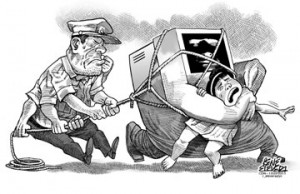
Using the state’s coercive force to arrest operators in Cordova town and elsewhere points the blame of the illegal activity on the family.
Often the suspects are as clueless as the victims about how deep the levels of harm go for this aberration.
The trauma suffered by children will takes years of professional help and compasionate caring to undo. The mere separation from their guilty parents leaves them with a broken family.
The elders who dragooned their children into the depravities of cyberpornography are bestial in the eyes of the law. However, arrests and raids are a last-stage response to what is actually a social problem.
Warped values in a community need a multi-pronged approach to address. Schools and teachers, parishes and religious elders, government social welfare agencies and political leaders, civic groups and citizens who care for their community –– all are needed in the effort to protect, first and foremost, vulnerable children who are being hawked like fresh meat to online voyeurs.
Given the extent of the problem – and we’re just scratching the surface of a dozen or so raids and “rescues” made in a single town of Cordova since 2011, authorities are responding with the tools that get the most visible results – law enforcement.
We see the ordinance that seeks to regulate money transfer outlets as a red herring.
Going after a commercial service that exists in villages where cyber pornography abounds as well as in regular places of economic activity is like cutting off one of the Hydra’s heads and having two more grow in its place.
Closing down one outlet doesn’t mean business can’t be transacted elsewhere. The time spent requiring a business owner to record all transactions and showing them to a government bureaucrat who has no training in spotting a cybercrime exchange is just wasting everyone’s time.
Let experts like the NBI and Homeland Security trace the cybercrime peddlers and clients with their sophisticated equipment.
Introducing restorative justice as a holistic approach is one solution. It emphasizes repairing the harm caused by criminal behavior, and was used in healing the effects of genocide in Rwanda in 1994.
It requires local government units to take the lead with other stakeholders in the community cooperating. It involves giving opportunities to offenders to make amends, reintegrating the offenders and victims to become productive members of the community and listening to the voices of all parties in this painful experience.